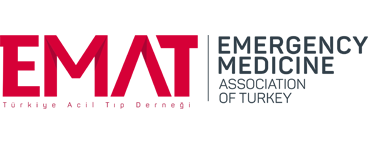Evaluation of factors affecting the success of non invasive mechanical ventilation in acute cardiogenic pulmonary edema in the emergency department
Özge Akdemir Urgancı , Yusuf Ali Altuncı
, Yusuf Ali Altuncı , İlhan Uz
, İlhan Uz , Funda Karbek Akarca
, Funda Karbek Akarca
Department of Emergency Medicine, Ege University Faculty of Medicine, Izmir, Türkiye
Keywords: Emergency department, heart failure, noninvasive ventilation, pulmonary edema
Abstract
OBJECTIVES: The aim of this study was to evaluate the factors associated with non invasive mechanical ventilation (NIMV) failure in acute cardiogenic pulmonary edema (ACPE) diagnosed in the emergency department.
METHODS: This study was prospectively conducted at the Ege University Faculty of Medicine ED between February 19, 2021 and December 01, 2021. Patients who received NIMV with ACPE were included. Patients’ clinical and laboratory parameters, treatments, NIMV mode, and settings were recorded. The primary endpoint was NIMV failure (intubation within 24 h). Secondary endpoints were early NIMV failure, early mortality (within 24 h), and in hospital mortality. Early NIMV failure was defined as follows: if the patient had a respiratory rate of more than 25 per minute, oxygen saturation below 90%, PaCO2 >50 mmHg in blood gas, and pH <7.35, 1 h after starting NIMV.
RESULTS: Out of 347 patients in this study, 34 (10.7%) of them intubated within 24 h. Female sex percentage was 48.7%. Median age was 73 years. Risk factors for NIMV failure were respiratory rate >40.5, systolic blood pressure <122.5 mmHg, Glasgow Coma Score <14, pH <7.21, lactate level >5.2 mmol/L, base excess <−4.5 mmol/L, B type natriuretic peptide level >3007 pg/mL (respectively area under the curve values; 0.723, 0.693, 0.739, 0.721, 0.690, 0.698, and 0.616).
CONCLUSION: Signs of hypoperfusion such as low systolic blood pressure (<122.5 mmHg) and high lactate (lactate level >5.2 mmol/L) are risk factors for NIMV failure. Evaluation of initial vital signs and arterial blood gas parameters is significantly important for prediction of NIMV success in ED.
How to cite this article: Urgancı ÖA, Altuncı YA, Uz İ, Akarca FK. Evaluation of factors affecting the success of non invasive mechanical ventilation in acute cardiogenic pulmonary edema in the emergency department. Turk J Emerg Med 2025;25:47-54.
Our study received ethical approval from the Ege University Clinical Research Ethics Committee with decision number 21‑2.1T/44 on February 19, 2021. Patient enrollment began after obtaining ethical approval. The study protocol conforms to the ethical guidelines of the 1975 Declaration of Helsinki as reflected in a priori approval by the institution’s human research committee.
OAU: Data curation, Investigation, Methodology, Writing‑ Original draft preparation YAA: Data curation, Methodology, Conceptualization, Formal Analysis IU: Conceptualization, Formal analysis, Investigation, Methodology, Writing‑ review and editing FKA: Conseptualization, Methodology.
None Declared.
None.

